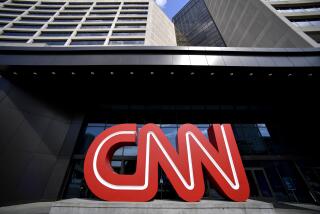TV AND THE GULF WAR : Hussein’s CNN Interview Shows His ‘Use’ of TV
- Share via
To most American television viewers, Saddam Hussein is just the thief of Baghdad. And worse.
But with Cable News Network reaching an international audience, one wonders how viewers in other nations are responding not only to the Iraqi president, but also to the images of American top guns such as President Bush and Gen. H. Norman Schwarzkopf.
CNN said Wednesday that about 100 callers phoned its Atlanta headquarters after the network showed a 90-minute interview with Hussein, and that most of them were angry.
“Probably two-thirds or three-quarters wanted to know, ‘Why are you showing that interview of our enemy?’ ” said CNN spokesman Steve Haworth.
But in TV jargon, Hussein’s specialty is counterprogramming--on a worldwide scale because of CNN. Consider:
On Wednesday, Schwarzkopf, the commander of Operation Desert Storm, gave an upbeat briefing from Saudi Arabia--carried by all the networks--on progress in the Gulf War, complete with vivid tapes of bombings and reports of ground action.
He was the picture of a confident, macho authority, even showing a trace of anger at one point when he interrupted a lengthy query to ask whether it was a statement or a question.
Just the night before, meanwhile, Bush’s State of the Union address was another upbeat TV briefing for America. Repeated ovations for the President and American troops sent a message not only to U.S. viewers, but to those in other countries.
But in between those two positive-sounding TV events was the Hussein interview, conducted in Baghdad by CNN’s Peter Arnett. In fact, although it was completed Monday, it was broadcast only 1 1/2 hours after Bush’s State of the Union speech because of technical problems that delayed transmission.
Apparently, it was accidental, satellite-age upstaging on TV. And while the Hussein interview hardly had the same impact in America because Bush’s address was carried by all the major networks, viewers in other CNN client nations saw the President, the Iraqi leader and Schwarzkopf in the same broadcast sequence, and with the same kind of TV prominence.
Was it possible that Iraq somehow managed to time the delay of the Hussein interview in an attempt to upstage Bush? “Absolutely not,” said Haworth, noting the transmission problems and air raids that CNN reported all along were holding up the interview from which it earlier presented driblets that got through.
Hussein, however, was hardly unaware that Bush’s speech was scheduled for Tuesday when he granted the interview on Monday.
Curiously, despite all his bravado, Hussein was much less dramatic in his rambling interview--perhaps because Arnett had already reported its highlights by phone--while the conservative Bush was far more passionate.
But Hussein’s suit-and-tie attire and relaxed manner on television showed that he understands the visual subtleties of the medium, and possibly made him seem less threatening to viewers in some countries abroad.
However, Wednesday’s news--that Iraq had launched a ground attack on Saudi Arabia and that at least 12 U.S. Marines had been killed--brought images back to reality, especially as military footage, however censored, began to emerge.
And CNN has an even touchier decision to make each time Hussein decides he wants to use the network as a world forum to present one image while war footage shows another. Illustrating such traps, Arnett indicated before Wednesday’s hostilities that he may be seeing Hussein again.
In this electronic press-release war of controlled footage and official briefings, TV’s judgment is being severely tested by both sides--Hussein and those who want jingoistic, unquestioned coverage of the allies.
More to Read
The biggest entertainment stories
Get our big stories about Hollywood, film, television, music, arts, culture and more right in your inbox as soon as they publish.
You may occasionally receive promotional content from the Los Angeles Times.










